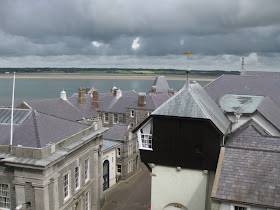After reading the Cadfael mysteries—which occur around Shrewsbury, England, just across from the Welsh Border—and having recently read The Reckoning—regarding Llewelyn II, the Prince of Wales’, attempts to keep his country free from domination by Edward III of England, I was delighted to finally set tire in this beautiful land several days ago.
This morning, we prepared to leave The Mountain on Anglesey, ate our breakfast and, sadly, took our leave of Denise and Gino—headed for Caernarfon Castle, Portmeirion and the Snowdonian National Park, en route to the charming village of Betwys-y-Coed.
Caernarfon Castle is the best preserved in Wales; it is huge, but allows you to wander almost anywhere; it is the place where Charles, Prince of Wales, was invested with his title, in 1969; it has an interesting military Museum of the Royal Welsh Fusiliers.
Caernarfon Castle

City View from the Castle

Tourists at the Castle

Investiture of Charles, Prince of Wales (1969)

Charles and Queen Elizabeth II at Investiture

The most surprising interpretive sign in the museum described how (many) wives would follow their husbands to war, receiving a very slight salary; more disturbingly, they would retrieve spoils from the fields—such as weapons, jewelry and teeth. These would be retrieved from the fallen on both sides. If someone were incapacitated, they would sometimes resort to relieving him of his life and his valuables—presumably in that order. The expectation of acquiring the spoils of war continues down to the present day—though the establishment of standing armies receiving regular pay, among other factors, has reduced the incidence of this practice greatly.
I have referred to these soldiers using a masculine gender; there was at least one exception: A woman disguised herself as a man and became a soldier, fighting alongside her husband; he was killed. Later, she was wounded and they discovered her identity; she was permitted to continue to serve; but, apparently, could only receive pay and benefits if she were married to a soldier—she was widowed several times before the end of her service.
A touching story of a woman connected to the Fusiliers recounts how she followed her husband to the front. When he was wounded, she lay by his side for 3 days, nursing him back to health; he survived and they both lived to a ripe old age—she outlived him, dying at 90.
Rain Suit at Caernarfon Castle. Does it come in a gargantuan size?

I have always wanted to visit Portmeirion, ever since I viewed The Prisoner television series in 1966-67 and discovered the shooting locale. I even suggested to another fan, who was visiting her daughter in Wales a number of years ago, that she check out the village.
Home of The Prisoner in Portmeirion: “You are Number Six”



This “Italian Village” is the extravagant creation of an architect who began a lifetime of work on it in 1925. Rick Steves says: “Surrounded by lush Welsh greenery and a windswept mudflat at low tide, the village is an artistic glob of palazzo arches, fountains, gardens and promanades filled with cafés, tacky shops, a hotel and local tourists who always wanted to go to Italy.” Walking the trails, even in the mud, was a delight.



Hydrangeas in Portmeirion—they lined the small lane into town and were everywhere around the town.

We continued on, driving through part of Snowdonia National Park; it is the second largest in Britain and has the tallest mountain in England or Wales—Mount Snowdon at 3,560 feet. Due to weather and time, we did not attempt to hike it—a couple at Caernarfon said they went yesterday and were unable to see the top. I found it lovely, though it is difficult to truly appreciate the surrounding beauty while driving on the “wrong” side of the road on narrow streets; I would say the physical beauty is a match for anything the rest of the British Isles has to offer; but, for emotional impact based on history—and the historical fiction of the Outlander series—Scotland is still a sentimental favorite.
We arrived at the campground on the edge of Betwys-y-Coed late in the afternoon—having missed only one turn and managing our turnarounds relatively quickly: Claire jumps out to ensure I don’t back into something and jumps back in once I can manage the turn; we quickly discovered that we had finally run out of LPG (Liquid Petroleum Gas); so, we cannot run our refrigerator; also, we could not cook a dinner; fortunately, the office is willing to stash our refrigeratables until we leave. We have had problems in some countries finding service stations where we could fill our LPG tank from the pump—as with Hydrogen Fuel cars; In Great Britain, the preferred method of storing cooking/heating/refrigerating fuel is in tanks that are exchanged for full ones, as needed. At any rate, we failed to find one today and there are none in the immediate vicinity. So, instead of raviolis, we had yogurt, cheese and crackers for dinner.
The final incident for today was that we seem to have lost the electric adapter that allows us to extend a second electric cord to remote power sources. This means that we either need to replace it—but, it’s expensive for occasional use—or do without: This means either parking close to the power source or borrowing another extension from the campsite wardens (neither option can be relied upon, unfortunately).
To travel is to discover that everyone is wrong about other countries. ~ Aldous Huxley
Definitely putting Portmeirion on my list! I think I would love Wales. Good pictures...
ReplyDeleteKarin on Paros